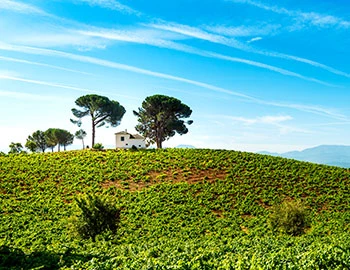Schaffhausen
Schaffhausen: the elegance of the north
The northernmost vineyards in Switzerland are located in wine-growing villages such as Thayngen and Schleitheim. Nevertheless, the high quality Pinot Noir selections from here show an amazing richness and fruit. To express solidarity with this leading red variety, the wine-growing canton gained the name “Blauburgunderland.” The red variety occupies around 70 percent of the total cultivation area of 500 hectares, where it yields wines of astounding diversity.
White wines from Schaffhausen
Red wines from Schaffhausen
Looking at a map of Switzerland shows that a substantial portion of the vines in Schaffhausen are grown north of the Rhine, in Klettgau or Stein am Rheine. It is natural to assume that these northernmost sites in Switzerland are also the coolest, but they are not. Located in the rain shadow of the Black Forest, usually just 800 millimetres of rain per year per square metre fall in Schaffhausen's terroirs – significantly less than in the neighbouring wine-growing cantons of Zurich and Thurgau.
A puzzle of soils
The soil conditions here are also multi-faceted. In wine-growing communities such as Hallau, Oberhallau or Gächlingen, deep soils with high loam content prevail. Dense, powerful Pinot Noirs emerge here, with plenty of structure and backbone. In villages like Siblingen, Löhningen, Beringen, Osterfingen, and in the town of Stein am Rheine, markedly calcareous soils with a high proportion of sand, gravel or Nagelfluh (Stein am Rheine) can be found. The Pinots from these terroirs turn out slightly more elegant, more delicate and more finely flavoured.
Early wine exporter
As in many areas of Switzerland, it was the Romans who served as viticultural pioneers. Written records indicate that the Kloster Allerheiligen (All Saints’ Abbey) in Schaffhausen had vineyards in Hallau around 1100. In the late middle ages, a continuous vine-belt ran from Stein am Rheine through Thayngen and Schaffhausen to Klettgau. Grapes were cultivated in Schaffhausen on over 1,000 hectares at the end of the 16th century. Schaffhausen's vintners were also pioneers in exporting. In the 18th century, their wines were already being delivered as far as Bregenz. After the phylloxera invasion, however, viticulture only recovered slowly.
High-profile white specialties
Today, around 500 wineries contribute to a dynamic and quality-oriented renaissance. And although the region defines itself as “Blauburgunderland,” the white wines are also impressive. Some of the Chardonnays and Pinot Blancs cultivated here are among the best in Switzerland. In warmer years, even Bordeaux varieties ripen fully.









